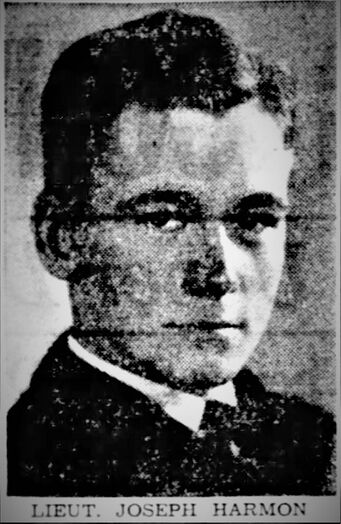JOSEPH F. HARMON, LT, USN
Joseph Harmon '39
Lucky Bag
From the 1939 Lucky Bag:
JOE FREDERIC HARMON
Battle Creek, Michigan
Joe, Face, Combullron
JOE started his career by taking Law at the University of Michigan. This inspiration, however, did not come entirely to naught, for when he obtained his appointment, he brought his inclination toward liberal arts to the Academy and soon talked himself into the Quarterdeck Society, an enviable class standing, and the position of Combullron. Of the many privileges of this latter position, he especially appreciates getting some of that good sleep. And with his "Navy line" it is inevitable that as extra-curricular activity he should specialize in snaking, although several brickings and squelchings have almost placed him back into the ranks of the misogynists. Because of his sound judgment in practical matters and his loquacity, he will probably find a desk in the Judge Advocate General's Office.
Quarterdeck Society 4, 3, 2, 1; Interbattalion Debate Championship 3; Glee Club 4, 3, 2, 1; Boat Club 4, 3; Trident; 2 Stripes.

JOE FREDERIC HARMON
Battle Creek, Michigan
Joe, Face, Combullron
JOE started his career by taking Law at the University of Michigan. This inspiration, however, did not come entirely to naught, for when he obtained his appointment, he brought his inclination toward liberal arts to the Academy and soon talked himself into the Quarterdeck Society, an enviable class standing, and the position of Combullron. Of the many privileges of this latter position, he especially appreciates getting some of that good sleep. And with his "Navy line" it is inevitable that as extra-curricular activity he should specialize in snaking, although several brickings and squelchings have almost placed him back into the ranks of the misogynists. Because of his sound judgment in practical matters and his loquacity, he will probably find a desk in the Judge Advocate General's Office.
Quarterdeck Society 4, 3, 2, 1; Interbattalion Debate Championship 3; Glee Club 4, 3, 2, 1; Boat Club 4, 3; Trident; 2 Stripes.
Loss
His headstone is marked:
Joseph Frederic Harmon
Lieutenant U.S. Navy
Jan 19, 1917 July 22, 1943Graduate U. S. Naval Academy
Annapolis, Maryland 1939Aboard U.S.S. John D. Ford
At Manila, Dec. 7, 1941Naval Actions with Asiatic Fleet
in the Southwest Pacific
Battle of Macasscar Straits
First Major Engagement of
U.S. Navy in World War IIGraduate Naval Air Training
Pensacola, Florida 1943Killed in Plane Crash In Line
of Duty, Jacksonville, Florida
He was on his last flight of training at Naval Air Station Pensacola, Florida when he crashed.
Other Information
From the Battle Creek Enquirer, October 30, 1942
Lieut. Joseph Harmon Declares Men on Home Front, War Front Must cooperate.
The American people, both on the home front and the fighting front, must cooperate if the war is to be won, Lieut. Joseph F. Harmon of the navy told members of the Kiwanis club Thursday.
Speaking on his experiences in the Pacific war zone since Pearl Harbor, Lieutenant Harmon said, “When I came home on furlough recently, I was surprised at the dissention on the home front. I don’t suppose I was as much surprised, though, at the dissention as I was at the fact that no one seemed to be concerned that he had any responsibility in the conduct of the war. Government said it was a matter for labor and capital, and labor and capital said it was the responsibility of government.
“The men on the ships of our navy blame labor for the fact that the American war effort is lagging. Officers on the ships blame managers of industry. But regardless of who is to blame, let’s all – civilians and service men – work together. You can’t win a football game, you can’t put over a drive like your What-Not sale, and you can’t win a war without cooperation and work. It’s time we all realized that and got busy.”
Played “B” Team”
Lieutenant Harmon in reviewing his experiences said the American fleet after Pearl Harbor might be compared to a “B” team of a college football squad. He recalled that while he was attending the University of Michigan a year after graduation from Central high school here, Georgia Tech sent its varsity and its “B” squad to the university for games. The “B” squad played the university’s “B” squad in the morning. But the varsity was delayed by a train wreck, so the “B” team had to play the U. of M. varsity until its own varsity could arrive.
“We were the Pacific fleet’s “B” squad,” he stated. “The main fleet, or varsity, was wrecked at Pearl Harbor so it was our job to keep the Nips from scoring too many touchdowns before the varsity could be rebuilt.”
Lieutenant Harmon told of convoying ships out of Cavite harbor, leaving the base for the last time just 20 minutes before the Japanese bombed it. He also described the battle of Macassar straits, which he said was probably one of the “wildest” sea battles in history. Four old American destroyers, all of them rusting and leaking oil from their seams, were given the task of stopping a Japanese convoy, which was supposed to have in it about 40 troop transports, 10 destroyers and several cruisers. He said after the Americans had out-maneuvered the destroyers guarding the convoy, they ran through the convoy several times, sinking a number of ships on which were about 10,000 Japanese troops. He also read a poem he had written, called “The Massacre at Macassar.” He was on the old destroyer, Ford, in that battle.
Torpedo Just Misses
He told also of a naval force consisting of two Dutch cruisers, a Dutch destroyer and two American destroyers, attacking a convoy bearing troops to Java. He said that, while the Dutch destroyer was sunk trying to fight it out with a Japanese cruiser, several Japanese ships were sunk when they turned on each other in the dark, each ship thinking the others were enemies. He read another poem he had written about this engagement. The other engagement he told about was the battle of Java sea, when the ship he was on was missed by only a few yards by a Japanese torpedo.
From the Battle Creek Enquirer, July 24, 1943
“Lieutenant Harmon served aboard both destroyers and a cruiser, the USS Chicago, which has since been lost in action against the Japanese. He was on a destroyer, the Ford, at Manila, when the Japs first struck in December, 1941. He afterwards was in the battles of Midway and the Coral sea. His first promotion, from ensign to lieutenant, junior grade, came after an act of vigilance, when, while he was on duty in the crow’s nest of his ship, he spotted approaching torpedoes and sounded an alarm in time for the ship to avoid them.
Later he was commended for having rescued a seaman, who, temporarily insane and armed with a large knife, had leaped overboard in shark-infested waters, Lieutenant Harmon leaped in after the seaman, disarmed him and hauled him back aboard the ship with the help of others who tossed a life preserver to him.
He described some of his experiences at sea when he addressed the Kiwanis club and the Men’s Fellowship of the First Congregational church while home on leave in October, 1942.
While a student at Central high school he was especially well known because of his oratory. Subsequently, while a midshipman at Annapolis in 1936, he won an academy speech competition. He took pre-[law] work at the University of Michigan for a year before entering the naval academy.
From Battle Creek Enquirer, July 28, 1943
More than 500 persons attended [his funeral] services. Two guards of honor, from the Grosse Isle naval training station, stood, one at enter end of the casket, throughout the service.
At Oak Hill cemetery, where burial services were held, a 16-man firing squad from Fort Custer fired a final salute to Lieutenant Harmon and the service closed with the playing of “taps.”
From researcher Kathy Franz:
Joseph with two others won first honors for Battle Creek High School in spring 1934 and was on the University of Michigan debate team in the fall. In his high school yearbook, Characteristic: Aggressiveness. Apparent Aim: At the bar. Hobby: Being silent.
Joseph had only been married three weeks when he died. His parents were just about on their way to meet him and his bride in Chicago. He was just finishing a two-month special course in dive bombing at Cecil Field, Jacksonville. His plans were to go to Chicago for a three-week course in aircraft carrier work. Then after a 10-day leave, he would return to Jacksonville as an instructor.
In 1930, his father Joe was a building contractor. His mother was Anna, sisters M. Elizabeth, Ann, and one another. He was also survived by three uncles.
Photographs
Bronze Star
A classmate presented his parents with Joseph's Bronze Star with Combat "V" in 1950.
For meritorious service as first lieutenant and damage control officer of the USS John D. Ford during operations against enemy forces in the Netherlands East Indies, from December 8, 1941, to March 4, 1942. Exceptionally skilled and resourceful in maintaining the hull and fixtures of the John D. Ford at a high state of material readiness despite the strain of sustained operations and the lack of navy yard overhaul and adequate tender overhaul facilities. Lieutenant (then lieutenant, junior grade) Harmon rendered invaluable assistance to his commanding officer in combatting Japanese invasion forces off the Netherlands East Indies. Lieutenant Harmon's ingenuity, perseverance and conscientious devotion to duty reflect great credit upon himself and the United States naval service.
The "Register of Commissioned and Warrant Officers of the United States Navy and Marine Corps" was published annually from 1815 through at least the 1970s; it provided rank, command or station, and occasionally billet until the beginning of World War II when command/station was no longer included. Scanned copies were reviewed and data entered from the mid-1840s through 1922, when more-frequent Navy Directories were available.
The Navy Directory was a publication that provided information on the command, billet, and rank of every active and retired naval officer. Single editions have been found online from January 1915 and March 1918, and then from three to six editions per year from 1923 through 1940; the final edition is from April 1941.
The entries in both series of documents are sometimes cryptic and confusing. They are often inconsistent, even within an edition, with the name of commands; this is especially true for aviation squadrons in the 1920s and early 1930s.
Alumni listed at the same command may or may not have had significant interactions; they could have shared a stateroom or workspace, stood many hours of watch together… or, especially at the larger commands, they might not have known each other at all. The information provides the opportunity to draw connections that are otherwise invisible, though, and gives a fuller view of the professional experiences of these alumni in Memorial Hall.
October 1939
June 1940
November 1940
April 1941

The "category" links below lead to lists of related Honorees; use them to explore further the service and sacrifice of alumni in Memorial Hall.




